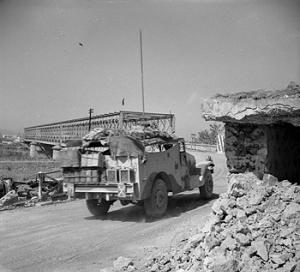Operation Fustian
| Operation Fustian | |||||||
|---|---|---|---|---|---|---|---|
| Part of the Allied invasion of Sicily | |||||||
 Primosole Bridge after capture, with damaged pill box on the right. |
|||||||
|
|||||||
| Belligerents | |||||||
|
|
|
||||||
| Commanders and leaders | |||||||
|
|
|
||||||
| Units involved | |||||||
|
1st Parachute Brigade 50th (Northumbrian) Infantry Division |
1st Fallschirmjäger Division 213 Coastal Division |
||||||
| Casualties and losses | |||||||
| 141 dead 168 missing or wounded 41 Dakota 1 Albemarle 5 Waco gliders |
Unknown | ||||||
Operation Fustian was an airborne forces operation undertaken during the Allied invasion of Sicily in July 1943 in the Second World War. The operation was carried out by Brigadier Gerald Lathbury's 1st Parachute Brigade, part of the British 1st Airborne Division. Their objective was the Primosole Bridge across the Simeto River. The intention was for the brigade, with glider-borne forces in support, to land on both sides of the river. They would then capture the bridge and secure the surrounding area until relieved by the advance of British XIII Corps, which had landed on the south eastern coast three days previously. Because the bridge was the only crossing on the river and would give the British Eighth Army access to the Catania plain, its capture was expected to speed the advance and lead to the defeat of the Axis forces in Sicily.
Many of the aircraft carrying the paratroopers from North Africa were shot down or were damaged and turned back by friendly fire and enemy action. Evasive action taken by the pilots scattered the brigade over a large area and only the equivalent of two companies of troops were landed in the correct locations. Despite this and the defence by German and Italian forces, the British paratroops captured the bridge, repulsed attacks and held out against increasing odds until nightfall. The relief force led by the 50th (Northumbrian) Infantry Division, under Major-General Sidney C. Kirkman, which was short of transport, were still 1 mile (1.6 km) away when they halted for the night. By this time, with casualties mounting and supplies running short, the parachute brigade commander, Gerald Lathbury, had relinquished control of the bridge to the Germans. The following day the British units joined forces and the 9th Battalion, Durham Light Infantry, with tank support, attempted to recapture the bridge. The bridge was not finally secured until three days after the start of the operation, when another battalion of the Durham Light Infantry, led by the paratroopers, established a bridgehead on the north bank of the river.
...
Wikipedia
